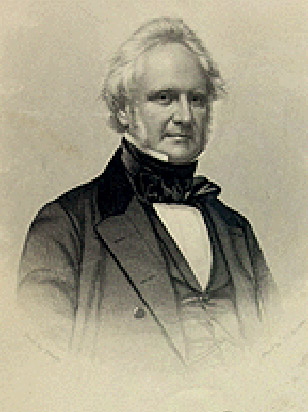Toward the end of the nineteenth
century, philanthropist Andrew Carnegie argued that the wealthy had a moral
obligation to give away a portion of their assets. He advised fellow millionaires
to make their benefactions during their lifetimes to ensure that the funds
were directed towards the uses they intended. Carnegie cited the man who
had inspired his philosophy of charitable giving.That man was George Peabody.
Hailed in his lifetime as "the most
liberal philanthropist of ancient or modern time," Peabody is recognized
today as the founder of modern philanthropy. To be sure, his benefactions
have been overshadowed by the much larger contributions of later donors,
but it was he who set the example for and established the pattern followed
by Andrew Carnegie, John D. Rockefeller, and the other great philanthropists
of the nineteenth century. The Peabody Donation Fund, which provided housing
for London's poor and the Peabody Education Fund, which helped to heal
the wounded South, were the prototypes for the modern philanthropic foundation,
but it was not until the twentieth century that these models were widely
emulated.
In 1815, George Peabody persuaded
his partner Elisha Riggs to move their firm, Peabody & Riggs, to Baltimore.
They settled into larger quarters in Old Congress Hall and added banking
services to the firm's business. Their banking ventures quickly became
a source of great profit. By 1822, Peabody & Riggs branches were established
in Philadelphia and New York.
George Peabody's $2 million
gift establishing the Peabody Education Fund supported education at all
levels in the eleven former Confederate states and West Virginia.
Many northerners and southerners alike believed this ambitious venture
was the surest means of healing the wounds left in the wake of the Civil
War.
The first meeting of the trustees
of the Peabody Education Fund was held
at Willard's Hotel in Washington,
D.C., on February 8, 1867. There, former governors of northern and southern
states mingled for the first time since the beginning of hostilities.
When the trustees gathered a month later in New York City the occasion
was recorded by renowned Civil War photographer Matthew Brady.
The Peabody Education Fund, which
established a public education system for the states of the American South,
was George Peabody's largest single benefaction. Taking a position
that was astonishing for that era, Peabody insisted on providing educational
opportunities for all races. General Ulysses S. Grant, Admiral David G.
Farragut, and the governors of New York, Massachusetts, Virginia, and South
Carolina were among those chosen as trustees for the Fund. Peabody
was awarded a Congressional Medal for his benefaction.
I feel most deeply,
therefore, that it is the duty and privilege of the more favored and wealthy
portions of our nation to assist those who are less fortunate; and, with
the wish to discharge so far as I may be able my own responsibility in
this matter, as well as to gratify my desire to aid those to whom I am
bound by so many ties of attachment and regard, I give to you, gentlemen,
most of whom have been my personal and especial friends, the sum of one
million of dollars, to be by you and your successors held in trust, and
the income therefore used and applied in your discretion for the promotion
and encouragement of intellectual, moral, or industrial education among
the young of the more destitute portions of the Southern and Southwestern
States of our Union; my purpose being that the benefits intended shall
be distributed among the entire population, without other distinction than
their needs and the opportunities of usefulness to them.
-- George Peabody, February
7, 1867
President Millard Fillmore arranged
for transportation of American wares to Britain for the Great Exhibition
of 1851 but Congress, plagued with the slavery controversy and suspicious
of the British, denied funding for actual U.S. participation in this "speculative
venture." The American exhibits languished on the English docks
as the British press heaped scorn on the former colony. George Peabody,
recognizing the importance of his country making a good showing, put up
the £3,000 (about $15,000) needed to install the American exhibits
in London's Crystal Palace.
During George Peabody's time
in London there were acres of slums with tenements where basements were
awash in sewage. Upstairs rooms were so crowded with humanity that the
dead often lay packed amid the living for days. Women stood by their
infants and small children to protect them from rat bites. Dank rooms with
piles of rags for furniture might hold as many as thirty humans sleeping
on straw-filled bags.
There was no central water supply.
Water, often brought in from sources not far from sewage outlets, was furnished
by a variety of private companies. Cholera outbreaks were frequent and
lethal. For a time George Peabody considered establishing a network of
drinking fountains for the city.
The Peabody Donation Fund, which
provided housing for London's poor, and the Peabody Education Fund, which
helped the American South recover from the devastation of the Civil War,
were prototypes for the modern philanthropic foundation, but it was not
until the twentieth century that this method of directing money to good
causes was widely emulated.
Founded in 1857, Baltimore's
Peabody Institute was the first major cultural center in an American city.
It provided Baltimore with a research library, scholarly lectures in the
humanities and sciences, an academy of music, and a gallery of art.
When The Johns Hopkins University was established in 1877 the Peabody Board
of Trustees passed a resolution calling for the two institutions to affiliate
at the earliest possible time. A century later, in 1977, the Peabody Institute
affiliated with The Johns Hopkins University. |
